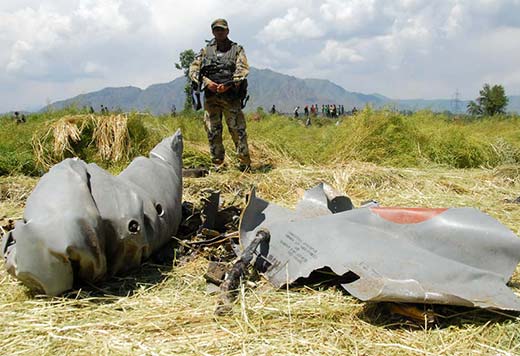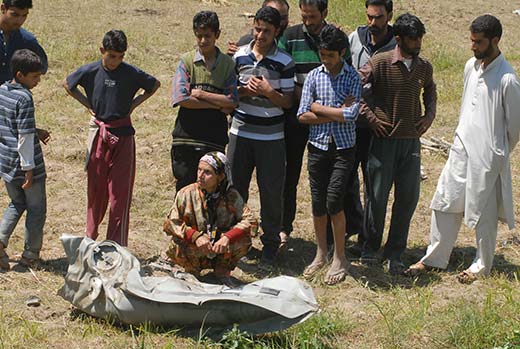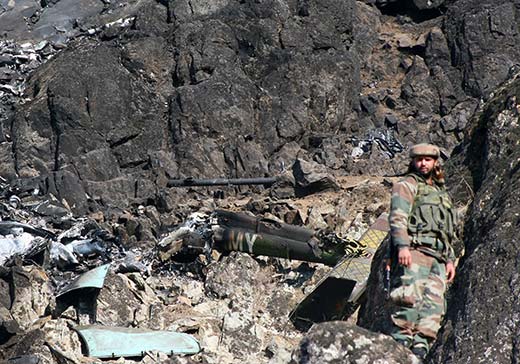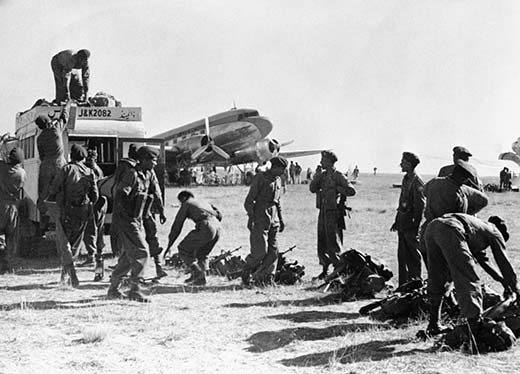Last week’s chopper crash at Safapora was neither the first one nor is expected to be the last air crash in Kashmir. Since 1947 when aircrafts started flying over the Vale, more machines were lost to mountains than to battle. After nearly 100 air crashes across J&K, R S Gull drafts aviation history’s first Kashmir chapter

Pic: Bilal Bahadur
“What wrong did my son do?” journalist Rahul V Pisharody reported an inconsolable Sarver Khan crying near the corpse of his son Major Taher Hussain at their Suraram home in Hyderabad’s Qutbullapur Mandal. “He got married just eight months ago!” An aviator with 202 Army Aviation Squad, Taher died on February 11, 2015 evening along with Lt Col Rajesh Ghulathi when their Dhruv chopper crashed over Laaman hillock in Bandipore’s Takiya hamlet.
The two had taken off from Army Aviation Base at Safapora that was set up in 2007, on a routine test flight. In bad weather situation, they apparently lost the track, hit a cliff and crashed.
Khan had done no wrong. The crash that killed Gulati and Khan was probably the 95th crash in Kashmir involving IAF (involving all flying machines) since historic maiden landing by Biju Patnaik’s at the run down air strip over Srinagar’s Damoder heights on October 27, 1947.
During those tumultuous days of 1947, flying machines were in demand. In fact, Hari Singh, the despot that was ruling Kashmir, was desperate to fly out after the tribal irregulars gnawed his state. A spendthrift, he already was a proud owner of a silver-plated airplane – for which he had built two small airstrips at Jammu and Srinagar, but found it small and unsuitable for long distance flight. He initiated talks with Vickers to purchase a brand new Viking aircraft for his safe passage out of the Vale, his forefather had purchased. Well before the talks could conclude, he found his stay in Srinagar dangerous and fled in an 85-vehicle cavalcade on October 24, 1947.
“…Our resources in aircraft are limited,” Pandit Nehru wrote Maharaja the same day Patnaik landed in Srinagar, while accepting his request for accession with India. “Nevertheless we strained every nerve and got all the available planes and sent a considerable body of men to Srinagar today.”
That morning Biju Patnaik flew the first Douglas Aircraft Company Transport Airplane (Dakota) carrying 17 soldiers under Lt Col Dewan Ranjit Rai’s command to fight raiders. By January 1, 1949 when the ceasefire was announced and India’s first war over Kashmir concluded with bifurcation of Kashmir state and pushing the dispute to UN Security Council, Srinagar airstrip was used by 704 fighter and transport aircrafts making thousands of sorties.
IAF involvement, then Royal Indian Air Force, not only marked the beginning of J&K’s aviation history but also started an unending trail of crashes and accidents killing scores of people. Till date, nobody on earth knows what happens to the flying machines in J&K. Invariably the problem lies beyond faulty machines and the men who fly them.

Pic: Bilal Bahadur
In fact, within three days of the first landing, another Dakota, a C-47, on its way to Srinagar from Ambala went missing over Pir Panchal on October 30, 1947. With three pilots in cockpit and 22 soldiers on board, its wreckage was first located in June 1980, almost 33 years after, and a joint funeral of 25 personnel could take place on June 11, 1981.
J&K’s aviation history suggests that wars and conflicts took a fraction of toll as compared to days of peace. Even during wars, there were fewer casualties in actual battle and more in accidents around.
The first war (October 27, 1947 – Jan 1, 1949), the longest ever between India and Pakistan, for instance, led to 12 attritions of the flying machines in J&K. While five were actual battle casualties, seven were accidents. It was during this war when a Harvard T6 fighter was shot down by Pakistan taking the pilot and Blitz Bombay’s star reporter Prem Nath Sharma as prisoners. They were repatriated a year later and Sharma wrote his diary that remained a heroic account, to that generation of reporters.
The second war (August 5 – September 23, 1965) was perhaps the only conflict between the two countries in which all the seven aircrafts were destroyed in action and not a single one in accident. While an Otter DHC-3 was destroyed in Poonch on August 23, 1965, Pakistani F-86 Sabre destroyed four Vampire-FB52’s in Jammu war theatre on September 1, 1965. A Pakistani F-86 raided Srinagar on September 7 and destroyed a Dakota at Srinagar airport, an action repeated by B-57 Bomber in Jammu hitting another transport aircraft, next week.
In the third war (December 3-16, 1971), IAF lost seven aircrafts and five of them in action and only two in accidents. Four fighters were lost near Chmab in Jammu (December 6, 7 and 10) and one in Srinagar on December 14 when a Gnat was shot down.
The last conflict was localized and remained restricted to a series of ridges in Kargil in the summer of 1999 ending July 26. Two fighter aircrafts and a helicopter were lost – all in action.

Since 1984, however, Siachin Glacier has taken a huge toll on the men and the flying machines. Though there are records of around 13 helicopter crashes on highest battlefield of mankind ever, there could be more instances because everything happening over the glaciated battlefield is not making to the newspaper front pages. This is despite the fact that machines can never kill so much of people or destroy the machines as weather conditions does. Since chopper manufacturers across the world manufacture flying machines for normal battlefield, the defence forces are facing a heady task to manage machines that can suit their requirements. Even an advanced Dhruv is reportedly not suiting the terrain. But that is a different debate altogether.
Siachin apart, Ladakh as a region has remained a challenge for all kinds of flying machines. Given the air pressure, the commercial aircrafts can also fly to and from Leh only during early hours!
Ladakh region has witnessed some of the worst tragedies. The first tragedy was reported on February 7, 1968 when an Antonov transport plane was flying 92 soldiers from Chandigarh. After it crossed the deadly Rohtang Pass, pilot Flt Lt H K Singh was radioed to return owing to severe weather conditions. Moments later, it went missing. In 2003 a chopper claimed to have traced the wreckage but not recovered so far.
Another Antonov crashed moments after take-off from Leh on November 9, 1978 killing 70 soldiers. A year later, an HS-748 crashed around Leh on June 7, 1979 killing 28 persons on board. Even though the armed forces are flying couriers during winters, especially to Kargil, the machines have improved and they negotiate heights better now.
But accidents do take place. On September 25, 1992, a spectacle for media proved very costly when a MiG-21 pilot misjudged an approach and ejected but parachute failed paving way for the crash.
Negotiating the heights has remained a regular crisis for the flying machines of all kinds in aviation Kashmir history. The Panchals separating Kashmir from Chenab valley has remained the main death trap right from October 30, 1947 when the first Dakota crashed. Banihal consumed another Dakota on May 8, 1957, a Packet C-119 on January 1, 1963, and an Illyushin-14 on February 18, 1964 killing 13 persons including a Major General. Its wreckage was claimed in May 1964. Another Antonov crashed near Kishtwar on March 22, 1986 killing all the 17 on board.

And it does not exclude civil aviation. Unlike battle machines, the civilian aircrafts have been better performers in air. In last six decades, there are only three passenger aircrafts which crashed. The first was on November 13, 1947 when Air India’s Douglas Dakota C-47 crashed at Jammu. No details are known of any casualties. The second crash was reported on January 16, 1949 when another Douglas Dakota C-4 that Dalmia Jain Airways owned crashed on Banihal pass. Again, not much is known about the casualties.
The third crash is part of folklore. It took place on February 7, 1966 when a Fokker F-27 Friendship 200 leased to Indian Airlines crashed near Banihal Pass killing 37 passengers including four crew members. It was on way to Jammu from Srinagar. This is the crash that people remember as that of Hoon Heng, name of the cliff with which it hit and crashed. At the peak of winter, the government had no resources to manage recovery of the dead. Then, civil society led by Sopore businessman collected money and made all efforts to recoveries the corpses. The businessman who spearheaded the campaign had lost his son in the crash, individuals remember.
The terrain is also a major problem. The contiguity of the terrain and an un-marked LoC, unlike International Border, is a major factor. Possibility of straying increases in bad weather.
It has been happening intermittently since November 5, 1947 when pilot Fg Offr P V S Ram of a Spitfire-VIII lost way and balled out over Muree near Rawlpindi after his engine cut out before emergency forced landing. He was repatriated within a week.
During the 2005 earthquake that flattened a vast belt straddling the LoC, Pakistani choppers and relief aircrafts flew into J&K countless times. In fact, a US army Black Hawk was forced to land in Keran as it failed to locate the LoC. After preliminary investigations it was permitted to fly back in November 2005. On November 6, 2005 a UN chopper with 10 other foreigners on board landed at Adoosa in Uri, instead of Chakothi near Muzaffarabad. Between August 2005 and July 2007, the IAF had recorded 73 incidents of violations of Indian airspace by Pakistani aircrafts.
Bulk of these violations was reported during the relief and rehabilitation efforts after the October 2005 earthquake. In certain belts, especially in the devastated Neelam Valley, the relief helicopters belonging to US, UN and Pakistan could not land at the destination without straying into J&K for a minute or so.
Prior to the earthquake, the then Pakistan Prime Minister Shaukat Aziz’s helicopter once entered the Indian airspace in July 2005. Once an Indian minister’s chopper strayed into Pakistan and returned only after being warned of being shot down. An IAF Cheetah carrying four individuals strayed into Gilgit and was forced to land at Skardu on September 23, 2011. They were repatriated later.
As long as people will fly, accidents are bound to occur. That is perhaps why, some experts see J&K an equivalent to the “Hump” – trans-Himalayan operations across China involving flying over mighty Himalayas that US air force faced during World War II. There is not a spot where a crash has not taken place – Pulwama, Rajouri (on July 14, 1990 killing a Major General and a brigadier), Pampore, Poonch, Reasi, Doda, Sopore, Budgam (on December 26, 2002 when a MIG-21Bis landed on a house killing a civilian), Kargil, Awantipore. Flying machines even crashed into Wullar Lake (August 27, 1951), into Poonch river (on November 22, 1963 killing a Major General and Air Vice Marshal), Chenab (June 17, 1987) and more recently on October 30, 2009 in the Baglihar dam, even on the dried river-bed of Rembi-aar (February 3, 1962) and even hit power distribution poles.

Some accidents reported from J&K have harrowing details. Post Kargil, on August 18, 1999 two MIG-21 Bis fighters were taking off but very close. One lost control in the slipstream and crashed. As ATC asked him to eject, pilot of another aircraft mistook the call for him. Both ejected but lost both fighters.
Sonamarg has especially remained a challenging airspace. On October 7, 1998, a MiG-21 was lost at Nilgrath. On April 2, 2004, two of the four deep-penetrating Jaguar fighters went missing near Gund. An investigation later said bad weather reduced visibility and they clashed with each other.
But the dramatic accident linking Kashmir to an aircraft is Kashmir Princess, an Air India Lockheed L-749 Constellation that exploded in air on April 11, 1955 killing 16 people though three survived. This aircraft carried only the Kashmir name but emerges at the top of crash searches in virtual world. This aircraft was on its way from Bombay to Hong Kong to Jakarta when it exploded midair into the South China Sea. It was targeted to kill Chinese premier Zhou Enlai who skipped boarding it at the last moment.
On the private side, there have been a number of crashes. A chopper landed in Chenab and never gave a corpse or even a rotor blade. Even Dhirendra Barmachari, who was Indira Gandhi’s guru crashed in his microlight plane near Mantalai on June 9, 1994.
Even J&K government owned civil aviation department is also sitting on at least four wreckages since 1994, some of which still lies unclaimed over inaccessible peaks. One chopper crashed in Zainakote, another in Sonamarg during heli-skiing when a blade hit the glacier and the chopper crashed. The third crash was just near the Amarnath cave in 2001 and the fourth was on August 5, 2003 that led to the death of pilot J S Kahloon along with three other passengers near Ganderbal.
But J&K government has the most sophisticated flying machines now. Is IAF modernizing too?















